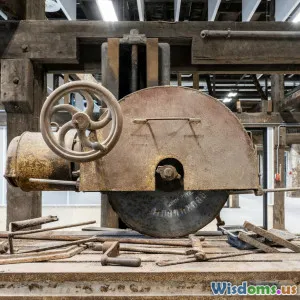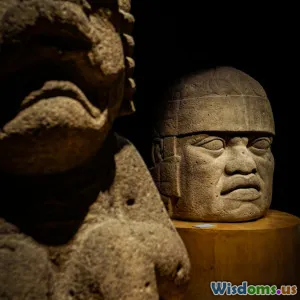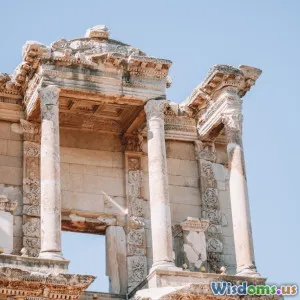
Seven Common Misconceptions About Ancient Greek Engineering
8 min read Discover the truth behind seven common misconceptions about Ancient Greek engineering and uncover the real innovations of this iconic civilization. (0 Reviews)
Seven Common Misconceptions About Ancient Greek Engineering
Ancient Greece often conjures images of philosophical thought, democracy, and art—but when it comes to engineering, many myths and misconceptions obscure the true prowess of these early innovators. From temples that have withstood millennia to pioneering hydraulic systems, Greek engineers laid much of the groundwork for modern technology. Yet, popular culture and outdated notions have clouded an accurate appreciation of their accomplishments.
Let’s unpack seven common misconceptions about Ancient Greek engineering and shed light on the reality behind their technological marvels.
1. Misconception: Ancient Greek Engineering Was Primitive Compared to Later Civilizations
Many assume that since Ancient Greece flourished before the Roman Empire and the Industrial Revolution, their engineering feats must have been rudimentary. In truth, Greek engineers introduced techniques that were revolutionary for their time and sometimes remained unparalleled for centuries.
Example: The use of precise stone-cutting techniques enabled magnificent structures such as the Parthenon to be built without mortar. The tight-fitting joints and carefully polished limestone blocks weigh tons, yet fit so perfectly that even a knife blade cannot slip between them. This precision influenced subsequent architectural methods.
Additionally, the ancient Greeks developed early forms of mechanical devices, including sophisticated cranes known as "geranos" (cranes) invented by Philip of Macedon. These cranes used compound pulley systems, a technology integral for erecting large columns and statues.
2. Misconception: Ancient Greeks Didn’t Understand or Use Concrete
Concrete is widely credited as a Roman invention, and while Romans significantly refined and expanded its use, Greek engineers were aware of and utilized concrete-like substances.
Archaeological findings suggest that Greeks employed lime mortars and pozzolanic materials to create durable binding compounds, particularly in harbor and foundation construction. For example, structures at the ancient harbor of Piraeus demonstrate early hydraulic concrete usage that resisted degradation from seawater.
This predates the massive Roman innovations and underscores that Greek engineers laid the groundwork for later mastery of concrete technologies.
3. Misconception: Greek Engineering Relied Exclusively on Manual Labor
The belief that Greeks built everything solely with human muscle ignores their understanding of mechanical advantage and early machinery.
Greek engineers implemented fundamental principles of levers, pulleys, and winches, combining them to increase efficiency and reduce labor demands. Heron of Alexandria’s work in the 1st century AD—with inventions such as the aeolipile (an early steam engine prototype)—exemplifies their mechanical knowledge.
Historical texts also reference assemblies of cranes and hoists capable of moving heavy stones weighing several tons during temple construction, proving their engineering was far from brute force alone.
4. Misconception: The Antikythera Mechanism Was a One-off Wonder Without Engineering Context
Discovered in a shipwreck off the coast of Antikythera, Greece, the Antikythera Mechanism is often depicted as an isolated marvel, leading to an impression that it was a freak accident of genius. In reality, this sophisticated ancient analog computer was part of a broader Greek tradition of mechanical ingenuity.
Dating to roughly 100 BC, the device traced celestial movements for calendrical and astronomical purposes—a feat requiring gear technologies, precise metalworking, and astronomical knowledge.
Similar but less complex geared devices appear in historical records, indicating that the knowledge to make such mechanisms was not unique but part of evolving engineering expertise.
5. Misconception: Ancient Greek Buildings Were Designed Primarily for Beauty, Not Structural Innovation
While Greek temples and theaters are renowned for their aesthetic harmony, their design also reflected advanced structural and geometric engineering concepts.
For instance, the Parthenon features subtle optical corrections such as entasis—the deliberate slight bulging of columns—to counteract visual illusions. But beyond artistry, this design also improved structural stability.
Moreover, the theaters of Epidaurus showcase an understanding of acoustics and mass construction techniques allowing thousands of spectators to hear performances clearly from vast distances. These feats require both artistry and astute engineering intertwined.
6. Misconception: Hydraulic Engineering Was Underdeveloped
The stereotype that water management was a later Roman or Islamic achievement neglects Greek innovations in aqueducts, drainage, and water supply.
The ancient Greeks designed and implemented cisterns, qanat-like tunnels, complex well systems, and urban drainage. For example, during the classical period, Athens was supplied with water through a system of tunnels and aqueducts like the Eupalinos Tunnel on Samos Island—two teams excavating from opposite ends using precise surveying methods met perfectly in the middle.
Their development of water clocks (clepsydras) also demonstrates sophisticated measurement and control of fluid dynamics, which had both practical and ceremonial applications.
7. Misconception: Ancient Greeks Had No Influence on Later Engineering Traditions
It is tempting to view Greek engineering as a closed chapter eventually eclipsed by Roman and modern innovations. However, Greek knowledge passed through Hellenistic and Byzantine periods directly inspired Islamic engineers during the Middle Ages and eventually Renaissance Europe.
For example, Vitruvius’ treatise "De Architectura"—deeply influenced by Greek engineers—remained a fundamental text for architects and engineers for over a millennium, shaping building techniques worldwide.
Moreover, ancient Greek mechanical principles can be traced to modern engineering concepts, including statics and dynamics formulations derived from Archimedes and others.
Conclusion
The excellence of Ancient Greek engineering extends far beyond marble temples and classical statues. By dispelling these seven common misconceptions, we reclaim an appreciation for their real achievements—advances in mechanical devices, construction methods, hydraulic systems, and scientific understanding.
Far from being primitive or purely aesthetic, Greek engineering was innovative, sophisticated, and foundational to much of the world’s technological progress. Exploring this rich legacy sparks not just admiration for the past but inspiration for future ingenuity.
Understanding and respecting these truths not only enriches our historical perspective but also invites modern readers and engineers to see the ingenuity in ancient solutions and the continuity of human innovation.
“The world will not be destroyed by those who do evil, but by those who watch them without doing anything.” —Attributed to Albert Einstein, echoing the call to actively dispel misconceptions and preserve knowledge.
Rate the Post
User Reviews
Popular Posts
















